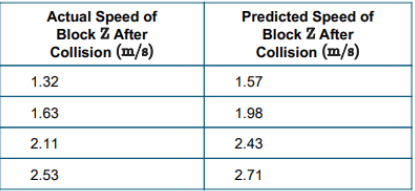(c) Why does the predicted speed of block Z after the collision not agree with the actual speed of block Z after the collision?
(c) Why does the predicted speed of block Z after the collision not agree with the actual speed of block Z after the collision?
Related questions
Question

Transcribed Image Text:Block W
M
Block Z
M
Figure 3. Initial Locations of the Blocks
Block W
Block Z
M
M
Figure 4. After the Collision
Actual Speed of
Block W After
Collision (m/s)
Actual Speed of
Block Z After
Collision (m/s)
Predicted Speed of
Block Z After
Collision (m/s)
0.1
1.32
1.57
0.1
1.63
1.98
-0.2
2.11
2.43
0.0
2.53
2.71
Students repeat the experiment but replace block X and block Y with block W and block Z, as
shown in Figure 3. Block W and block Z have identical mass M. When the experiment is
conducted, the students observe that the blocks do not stick together, as shown in Figure 4.
The students predict the speed of block Z after the collision by assuming that the collision is
perfectly elastic. They then collect data about the actual speeds of both blocks immediately
after the collision, as shown in the table.
(c) Why does the predicted speed of block Z after the collision not agree with the actual speed
of block Z after the collision?
Expert Solution
Step 1
Given : Actual speed of block Z and predicted speed of block Z after collision.

Explain why the actual speed of block Z after collision and predicted speed of block Z after collision do not agree with each other?
Trending now
This is a popular solution!
Step by step
Solved in 2 steps with 1 images
